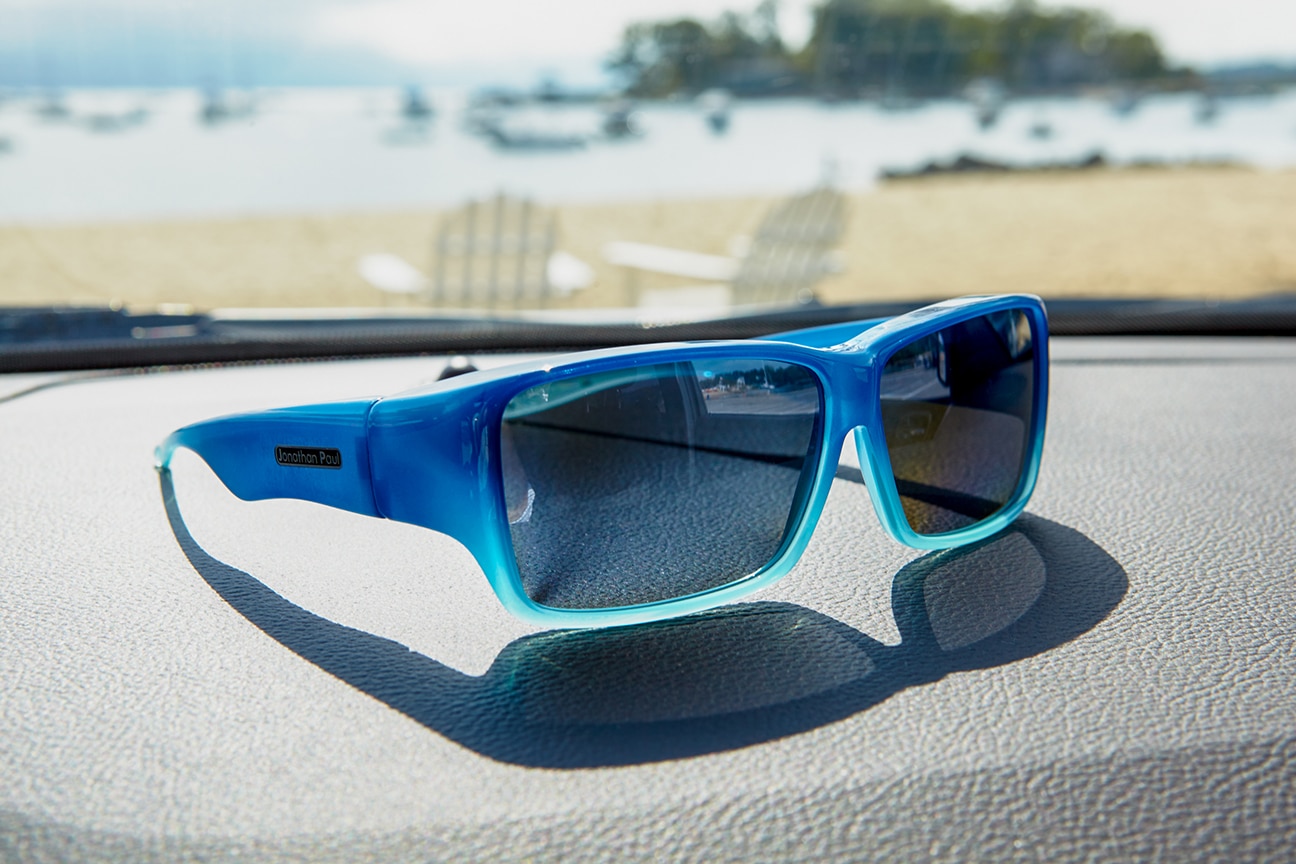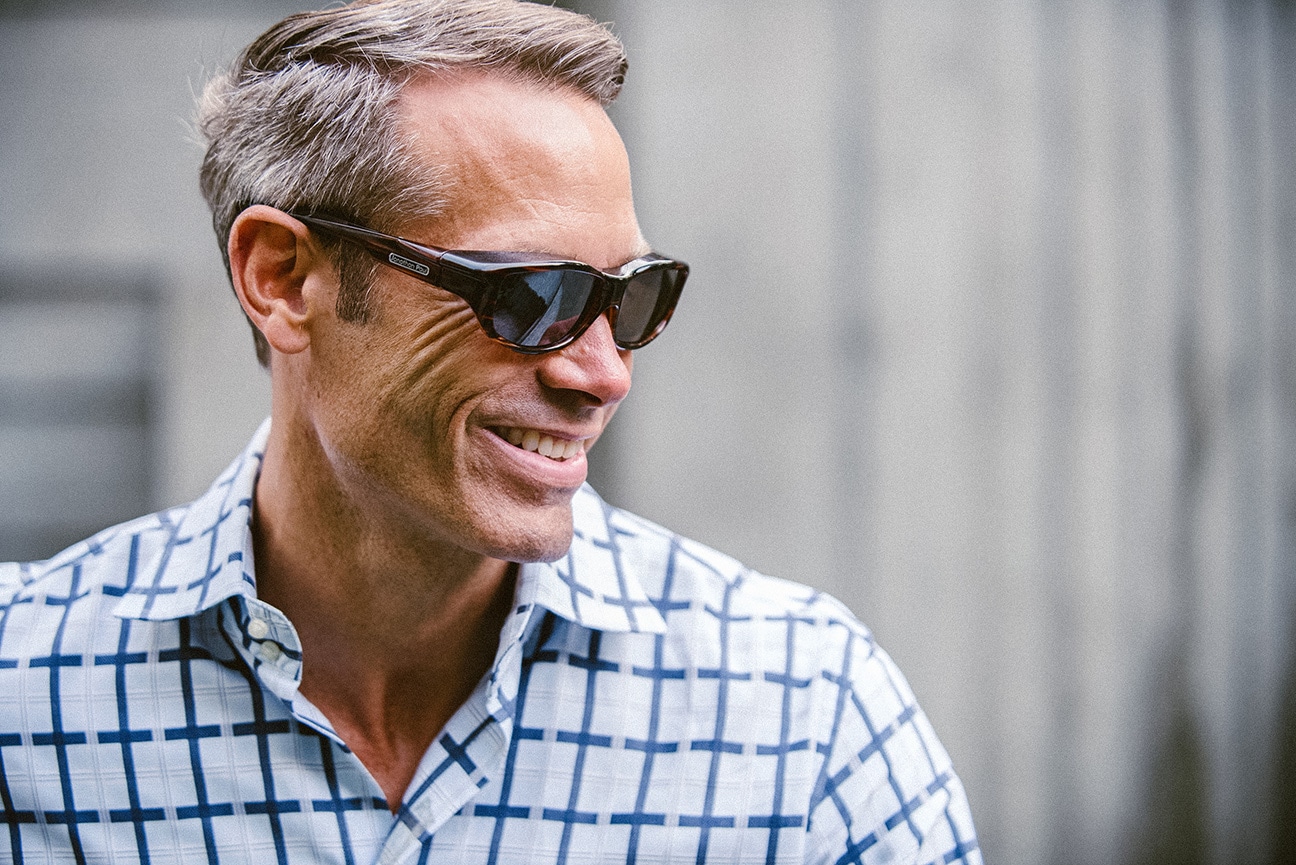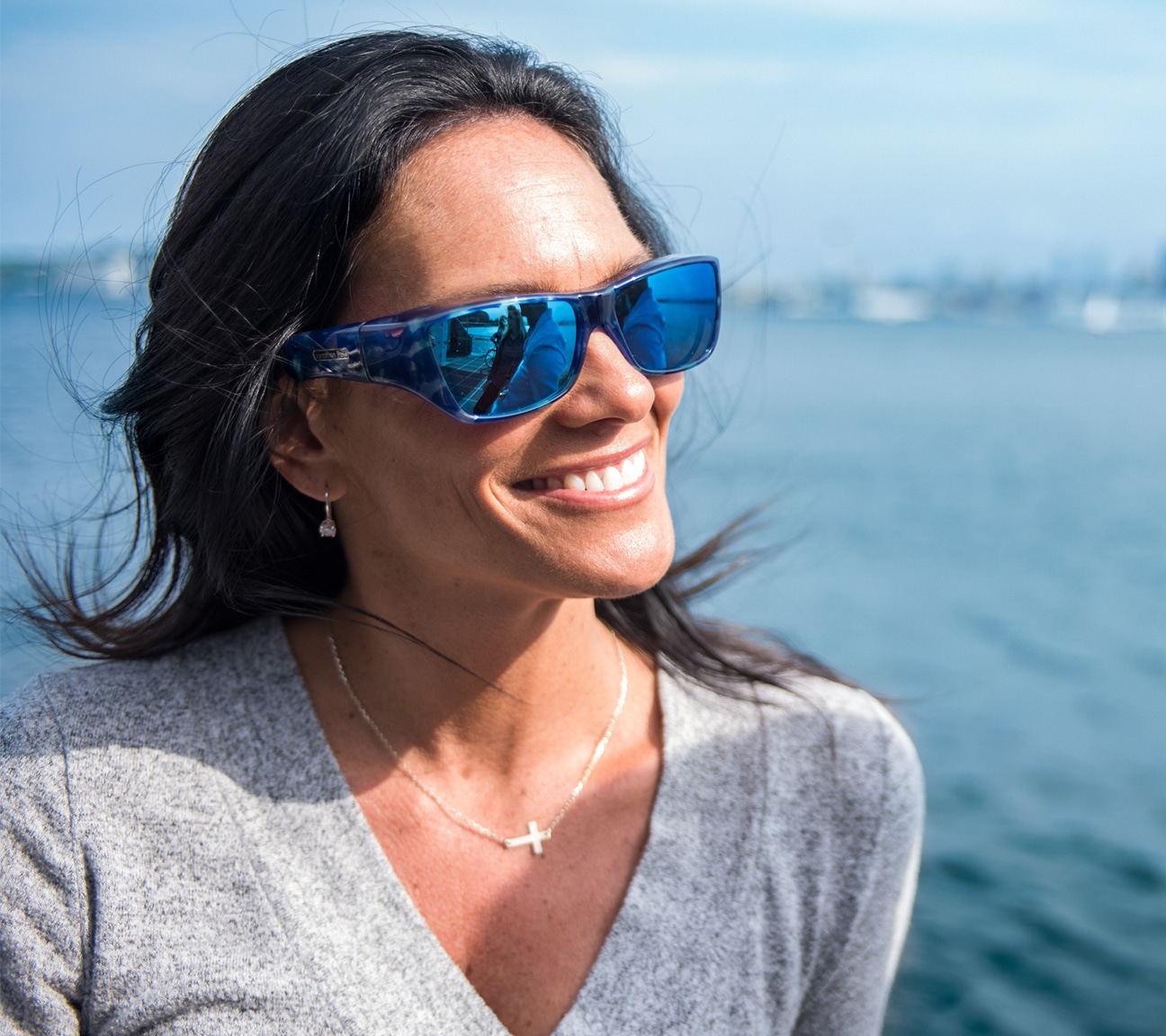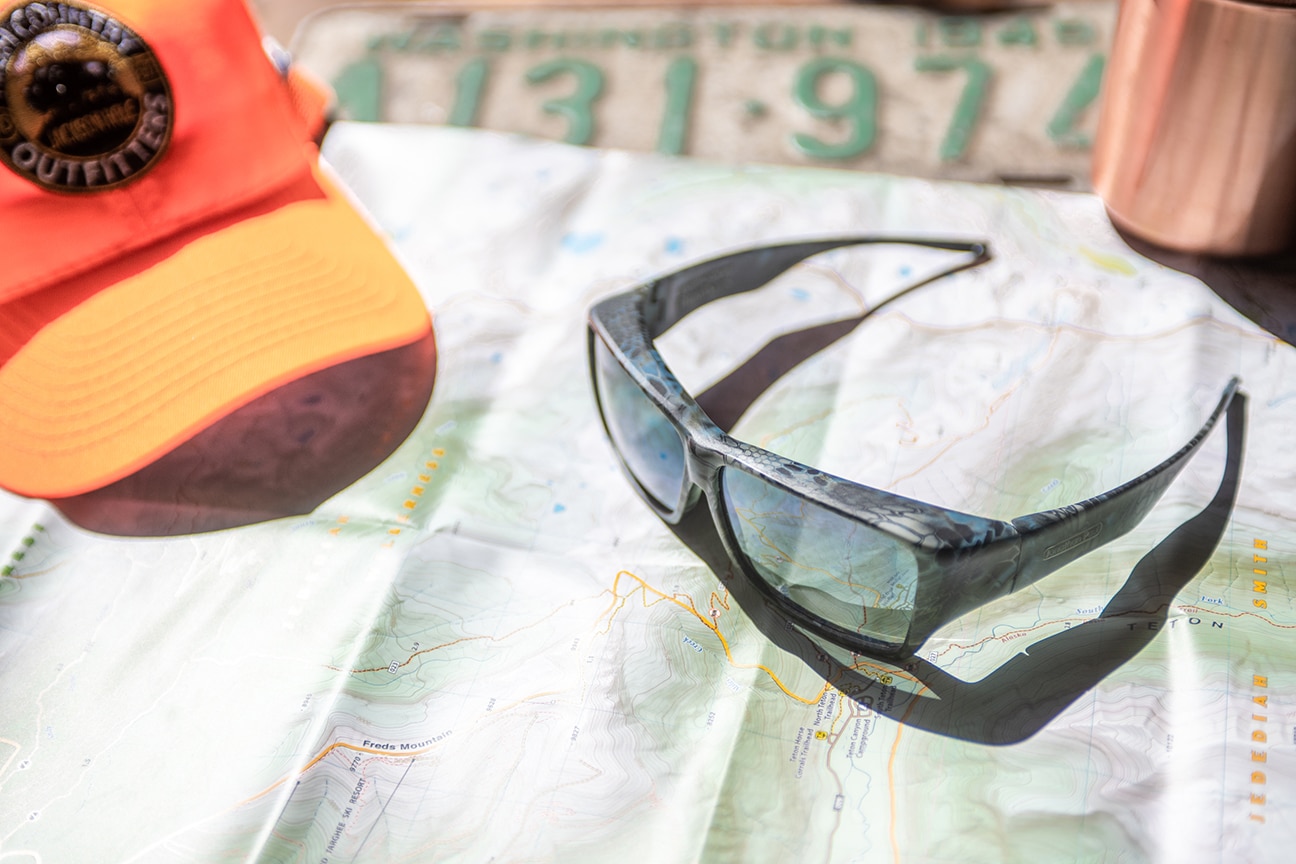We all know about the dangers that UV rays pose when it comes to our skin: skin cancer, premature aging, wrinkles. But many people don’t think about the harm that sun exposure can have on their eyes.
For skiers, runners and anyone who spends time outside, sunglasses are a must, even on cloudy days. Up to 70 percent of UV rays penetrate the clouds, says Christopher Bloise, an expert in ophthalmics.
“We need to reduce our UV contact,” says Bloise. “You need to wear sunglasses anytime you are outside, even on cloudy days.”
Certain types of UV exposure amplify the potential damage. Spring skiers heading for the slopes should be aware that being at high altitude — where the thinner atmosphere filters less UV radiation — is especially damaging to the eyes. UV and HEV (blue-light radiation) levels are also greater in wide open spaces, especially with highly reflective surfaces like snow, sand and open water.
Without the proper precautions, UV exposure has been linked to the following eye conditions:

Eye Conditions Caused by the Sun
Cataracts: A cataract is a clouding of the lens that affects vision. For people who have cataracts, seeing through cloudy lenses is a bit like looking through a frosty or fogged-up window.
“UV exposure can hasten the onset of cataracts,” says Bloise. It does this by causing the protein in the lens of the eye to clump and thicken, preventing light from passing through it.
Macular Degeneration: The macula is where we get our central and clearest vision. In macular degeneration, the tissue composition within the macula begins to change. This causes loss of central vision resulting in blurred vision and eventually blank spaces in vision.
This condition usually progresses slowly, but there is evidence that those with macular degeneration have had more sun exposure throughout their life. There are various treatments for macular degeneration depending on the severity of the case; however, there is currently no cure.
Photokeratitis: Also known as snow blindness or ultraviolet keratopathy, this condition causes swelling or inflammation of the cornea, which is the clear front covering of the eye. Symptoms include redness, blurred vision, tearing, light sensitivity, general pain and temporary vision loss for up to 48 hours. This can result from a day on the slopes or sunning on the beach without proper sun protection.
Pinguecula: Pronounced pin-GWEK-yoo-la. This is a white or yellow raised area or bump within the conjunctiva, which is the gelatinous layer that covers the white of the eye just outside the colored part. This condition is particularly common in those who live in very sunny areas.
Pterygium: Also known as “surfer’s eye,” this is a growth of pink, fleshy tissue on the conjunctiva — the clear tissue that lines your eyelids and covers your eyeball. It usually forms on the side closest to your nose and grows toward the pupil area. Being in bright sunlight for long hours — especially when you are on water, which reflects the sun’s harmful UV rays — increases your risk.
If this continues to grow, then it may lead to scarring of the cornea, which could lead to permanent vision loss or distortion. If the pterygium is progressing, surgery is required to remove it to save vision.

The Importance of Peripheral Protection
Important attributes to consider when purchasing sunglasses include the color of the lenses, polarization and the fit.
One of the best ways to protect yourself is by wearing sunglasses that block ultraviolet rays whenever you’re outdoors. But too many people are unaware of the dangers of peripheral UV.
“You can wear a great sunglass, but if the light is going around them, it will not be that helpful,” says Bloise.
That’s why you should wear sunglasses that block light from the side, top and bottom. Frames with a close-fitting wraparound style provide the best protection because they limit how much stray sunlight reaches your eyes from above and beyond the periphery of your sunglass lenses.

A Rainbow of Options
We know there are a variety of sunglass lens colors available, but we might not know what the difference is between one in another. Tints actually filter light in different ways, and some tints do a better job at blocking light than others.
Gray, Brown and Green all block UVA and UVB, but they have specific qualities of how they render color and contrast.
Gray lenses are the most common for sunglasses because they don’t change the value of color but are dark enough for bright sunny days, while not so dark that they impair vision. If your gray lenses are polarized, they also reduce glare, making them great for most activities. Gray lenses also aid in preventing eye fatigue, provide true color perception, and are ideal for scenes to be viewed in their most natural state.
Brown lenses are helpful in low-light conditions because they make an environment appear brighter. They also enhance contrast and depth perception and are great for overcast, hazy and foggy conditions. Also, brown sunglasses will block more of the high-energy blue light.
Green lenses do both, providing both better contrast than gray lenses and better color accuracy than brown lenses. And, because green lenses favor the transmittance of green light, they provide excellent visual acuity.

Polarization: When it’s a Good Thing
Polarization is also important, especially for those living and exercising at higher altitudes or out on the water. Polarized lenses have a special chemical applied to them to filter light. The chemical’s molecules are lined up specifically to block some of the light from passing through the lens. People who use polarized sunglasses for long stretches of time often say they are less tired than usual after hours of battling sun glare.
Polarized lenses block 99.9 percent of all reflected glare and provide 100 percent UVA and UVB protection. They also emphasize color definition and deliver more enhanced visual acuity.
But all of the benefits in the world don’t matter if they don’t look and feel good.
Not Your Grandparents’ Fitover
One of the best options for protecting your eyes from sun damage is fitover sunglasses.
Stephanie Humphreys recalls her first impression of fitover sunglasses, and it wasn’t a positive one.
“My grandparents wore them and I thought they were so dorky,” says the 52-year-old Austin resident. “I tried them on and they were so clunky.”
But with the new generation of fitovers that provide fashionable, comfortable options, Humphreys has changed her tune. She spends a considerable amount of time in the Texas sun gardening and exercising. Fitovers provide complete protection from harmful UV rays while enabling her to wear her prescription glasses.
Floating above your Frames
Jonathan Paul® Fitovers. — the Australian-born company that originated the fitover eyewear category over a quarter century ago — has incorporated several features that provide modern prescription frame wearers with a fitover sunglass that meets the needs of their frame styles and their lifestyles.
Their fitovers have an integrated brow bar, which makes the fitover’s frame feel as if it is literally floating above your prescription frame. Their “scout-fit temples” create a seamless fit with prescription eyewear, maximizing all-day comfort. The Jonathan Paul Fitovers website features a “What’s my Size” tool that allows consumers to enter the dimensions of their prescription frames. They are given a range of pre-selected options that are compatible with their glasses.
All Jonathan Paul® Fitovers models are built using TR90 Nylon, making them incredibly lightweight, durable and flexible (even in temperature extremes), while preserving richness of color and a longer-lasting quality.

Fashionable and Functional
To meet the needs of their active customers, the company has designed special models specifically for athletes and outdoorsy people. The company recently partnered with Kryptek— the leaders in innovative, technical hunting apparel — to introduce a line designed for those out in the field. This new Kryptek collection of sunglasses offers ultra-light, durable TR-90 nylon frames with polarized polycarbonate lenses that eliminate glare and deliver 100 percent protection from harmful UVA and UVB rays.
The newest generation of fitovers are fashionable as well as functional. Jonathan Paul® Fitovers Chic Kitty, for example, is a classic cat-eye style evoking images of Audrey Hepburn. The Allure is a new oval design in colors like turquoise, purple and satin black. The Pandera features rectangular styling in a wide range of color patterns.
“Folks are buying our products to fill a specific performance need, but at the same time, they also want to look great in the process,” says Chris McCullough, director of consumer brand marketing for Jonathan Paul® Fitovers.
What makes Jonathan Paul Fitovers best in class, is the excellent optical quality of their premium lenses: Zero distortion, optically correct, injected molded polycarbonate which is six times lighter and twenty times stronger than glass plus an oliophobic coating. This technically advanced lens is a truly not your grandfather’s fitover.

New Fitovers, New Look
Fitovers have advantages over traditional prescription sunglasses.
“We’re talking a fraction of the cost of high-quality prescription sunglasses, with the ability to simply remove your fitover frames when you head inside or out of the sun,” says McCullough.
But ultimately, while the style and fit are important, the popularity of fitovers can be attributed to a growing awareness about the importance of protecting our eyes from dangerous UV rays. You can also change up your look by buying a new pair of fitovers rather than purchasing an expensive pair of prescription glasses.
“As an eyewear industry, a lot of the dialogue can be focused around fashion,” says McCullough. “But more can be done to aid in elevating the discussion around eye health, and the risks associated with not wearing something to protect your eyes from the sun. That’s particularly true when you’re outside for long stretches, such as when skiing, boating or fishing.”
This article is thoughtfully sponsored by Jonathan Paul® Fitovers.




popularity of fitovers can be attributed to a growing
focused around fashion
As an eyewear industry, a lot of the dialogue can be focused around fashion
change up your look by buying a new pair of fitovers
particularly true when you’re outside for long stretches
Thank you for sharing this excellent information, the Importance of Sun-Proofing Your Eyes this information is good write-up. It’s really helpful for me! And If any have color blindness problem then go here and check all information.
Protection of eye from sunlight was quite neccessary, as UV can harm our eye sight. Fit your eye under a proper sun proofing material
article contains so much information
nice post
thank you for writing this artcile 🙂
Nice info!
Informative Post.
Thanks for sharing this informative blog.
Are you ready to take your fitness to the next level. Join MantraFit today and discover a world of online fitness program that will elevate your confidence.
ClaimMantra is renowned for its services, offering NABH/NABL/ISI Certification & Training. We provide quality hospital empanelment consultant acorss India.
CoupleMantra provides affordable online couple therapy by top therapists in the world.
TherapyMantra provides the best and affordable online therapy in USA. Our experienced therapists offer a wide range of counseling services tailored to your needs.
PrideMantra provides the best Online LGBTQ Therapy, from top therapists in the world.Take the first step towards a brighter future with our unmatched counseling expertise.
https://lgbtqiacounseling.com/
TherapyMantra provides the best and affordable online therapy in UK. Our experienced therapists offer a wide range of counseling services tailored to your needs.
https://therapymantra.uk/